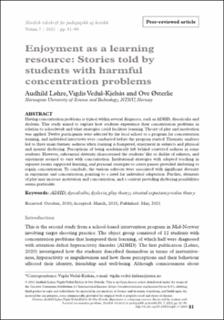| dc.contributor.author | Løhre, Audhild | |
| dc.contributor.author | Vedul-Kjelsås, Vigdis | |
| dc.contributor.author | Østerlie, Ove | |
| dc.date.accessioned | 2022-09-15T11:44:16Z | |
| dc.date.available | 2022-09-15T11:44:16Z | |
| dc.date.created | 2021-04-29T13:51:48Z | |
| dc.date.issued | 2021 | |
| dc.identifier.citation | Nordisk tidsskrift for pedagogikk og kritikk. 2021, 7 81-98. | en_US |
| dc.identifier.issn | 2387-5739 | |
| dc.identifier.uri | https://hdl.handle.net/11250/3018054 | |
| dc.description.abstract | Having concentration problems is typical within several diagnoses, such as ADHD, dyscalculia and dyslexia. This study aimed to explore how students experience their concentration problems in relation to schoolwork and what strategies could facilitate learning. Theory of play and motivation was applied. Twelve participants were selected by the local school to a program for concentration training, and individual interviews were conducted before the program started. Thematic analyses led to three main themes: sadness when learning is hampered, enjoyment in subjects and physical and mental sheltering. Perceptions of being academically left behind conveyed sadness in some students. However, substantial diversity characterised the students’ like or dislike of subjects, and enjoyment seemed to vary with concentration. Institutional strategies with adapted teaching in separate rooms supported learning, and personal strategies to create pauses provided sheltering to regain concentration. To conclude, the various subjects were associated with significant diversity in enjoyment and concentration, pointing to a need for individual adaptation. Further, elements of play may increase motivation and concentration, and a context providing sheltering possibilities seems preferable. | en_US |
| dc.description.abstract | Having concentration problems is typical within several diagnoses, such as ADHD, dyscalculia and dyslexia. This study aimed to explore how students experience their concentration problems in relation to schoolwork and what strategies could facilitate learning. Theory of play and motivation was applied. Twelve participants were selected by the local school to a program for concentration training, and individual interviews were conducted before the program started. Thematic analyses led to three main themes: sadness when learning is hampered, enjoyment in subjects and physical and mental sheltering. Perceptions of being academically left behind conveyed sadness in some students. However, substantial diversity characterised the students’ like or dislike of subjects, and enjoyment seemed to vary with concentration. Institutional strategies with adapted teaching in separate rooms supported learning, and personal strategies to create pauses provided sheltering to regain concentration. To conclude, the various subjects were associated with significant diversity in enjoyment and concentration, pointing to a need for individual adaptation. Further, elements of play may increase motivation and concentration, and a context providing sheltering possibilities seems preferable. | en_US |
| dc.language.iso | eng | en_US |
| dc.publisher | Cappelen Damm Akademisk | en_US |
| dc.relation.uri | http://dx.doi.org/10.23865/ntpk.v7.2663 | |
| dc.rights | Navngivelse-Ikkekommersiell 4.0 Internasjonal | * |
| dc.rights.uri | http://creativecommons.org/licenses/by-nc/4.0/deed.no | * |
| dc.title | Enjoyment as a learning resource: Stories told by students with harmful concentration problems. | en_US |
| dc.title.alternative | Enjoyment as a learning resource: Stories told by students with harmful concentration problems. | en_US |
| dc.type | Peer reviewed | en_US |
| dc.type | Journal article | en_US |
| dc.description.version | publishedVersion | en_US |
| dc.source.pagenumber | 81-98 | en_US |
| dc.source.volume | 7 | en_US |
| dc.source.journal | Nordisk tidsskrift for pedagogikk og kritikk | en_US |
| dc.identifier.doi | http://dx.doi.org/10.23865/ntpk.v7.2663 | |
| dc.identifier.cristin | 1907239 | |
| cristin.ispublished | true | |
| cristin.fulltext | original | |
| cristin.qualitycode | 1 | |

